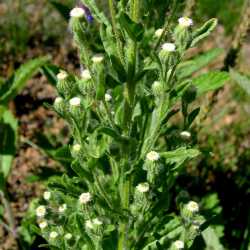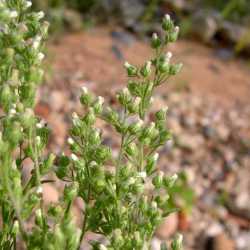Annuals or perennials, 10-120(-350+) cm (usually taprooted, sometimes with ± woody caudices). Stems usually erect, simple or branched from bases or throughout. Leaves basal and cauline (mostly cauline at flowering); alternate; sessile or petiolate; blades (usually 1-nerved) elliptic, linear, oblanceolate, oblong, obovate, ovate, spatulate, sometimes 1-2-pinnately lobed, ultimate margins toothed or entire, faces glabrate, hirtellous, tomentose, or villous, usually stipitate- and/or sessile-glandular as well. Heads obscurely radiate or disciform, borne in ± corymbiform, paniculiform, or racemiform arrays. Involucres ± turbinate, 2-7[-10] mm diam. Phyllaries 20-40+ in 2-4 series, appressed (usually reflexed in fruit), 1-nerved (nerves not orange or brown), lanceolate to linear, ± unequal to subequal, ± herbaceous medially, margins ± membranous, glabrate, hirtellous, tomentose, or villous, usually stipitate- and/or sessile-glandular as well. Receptacles ± flat, pitted or smooth, epaleate. Peripheral ('ray') florets 20-100(-200), pistillate, fertile; corollas yellowish (usually distally truncate or 2-5-toothed, sometimes with laminae 0.5-1+ mm). Disc florets 2-20[-30+], bisexual, fertile; corollas yellowish, narrowly funnelform, tubes shorter than throats, lobes 5, erect or spreading, deltate (lengths 2-2.5+ times widths); style-branch appendages deltate. Cypselae oblong to elliptic or obovate, compressed, margins thickened, riblike, faces glabrous, ± strigillose (hairs 0.05-0.1 mm), or densely sericeous (hairs 0.3-0.5 mm), often also stipitate- and/or sessile-glandular; pappi persistent, ± fragile, or readily falling, of 9-30+, white to tawny, ± equal, barbellulate, apically attenuate bristles in 1 series, or 30-40+ bristles in 2 series (outer usually shorter). x = 9.
G. L. Nesom (1990) argued for segregating some species from Conyza as members of Laënnecia. Although there are exceptions to each of the trends noted by Nesom, the rationale he presented is compelling. R. D. Noyes and L. H. Rieseberg (1999) demonstrated molecular differences that are consistent with treating laënnecias and conyzas in separate genera; at the same time, they showed Conyza to be 'nested' within Erigeron.






